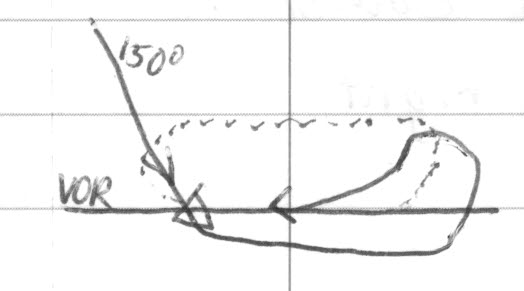- The airspace is protected on the holding-side of the holding pattern.
- You are guaranteed obstacle clearance and separation if flown correctly.
- Standard holding patterns are flown with right turns.
- Each circuit begins and ends at the holding fix.
- Begin timing for the outbound leg, when abeam the holding fix, or when completing the outbound turn if you can’t identify the abeam position.
- Adjust your outbound leg to make your inbound leg one minute. So if the wind is blowing you toard the navaid, make thou outbound leg longer.Adjusting Outbound Leg

- ATC will specify leg lengths in miles.
- To correct for crosswind drift, triple your inbound wind-correction angle on the outbound leg.
- Maximum Holding Speeds:
- 265 KIAS above 14,001′
- 230 KIAS 6,001′ to 14,000′
- 200 KIAS below 6,000′
- Holding Pattern Entries

- Direct Entry (a.k.a. Standard)

-
- Pass the fix
- Turn right to outbound heading
- Begin timing
- Turn right to intercept inbound course
- Generally appropriate whenever the outbound course is behind you.
- Teardrop Entry

-
- Pass the fix
- Turn to heading 30º left of the outbound course
- Begin timing
- Turn right to intercept inbound course
- Generally appropriate whenever the outbound leg is in front and to the right.
- Parallel Entry

-
- Pass the fix
- Turn to a heading that parallels the outbound course
- Begin timing
- Turn left to return to the holding fix or intercept inbound course
- Charted Holding Clearances Include:
- Direction to the hold
- Holding fix
- Expected further clearance time
- Additional Info for Uncharted Holds:
- The Holding Course – a specific radial, magnetic bearing, airway or route #
- Nonstandard pattern, if used
- The outbound leg length in minutes or nautical miles when DME is used
- Nonstandard Holding Patterns:
- Parallel Entry – used when the outbound leg is ahead and to the right
- Teardrop Entry – used when the outbound leg is ahead and to the left
- Visualizing Entry Procedures:
- Standard (Right Turns):
- Direct – when the holding course is behind you when on the fix
- Parallel – when the holding course is ahead and to the left
- Teardrop – when the holding course is ahead and to the right
- Nonstandard (Left Turns):
- Direct – same as above
- Parallel – ahead and to the right
- Teardrop – ahead and to the left
- Standard (Right Turns):

- Start timing for the 1st leg outbound in a nonstandard holding pattern when abeam the holding fix or when wings are level at the completion of the 1st turn, whichever occurs later.
- Timing for the outbound leg begins over or abeam the VOR, whichever occurs later.
- Start timing the inbound leg when completing not initiating, the inbound turn.
- Where a holding position is specified in lieu of a procedure turn, the holding maneuver must be executed within the 1-minute time limitation or DME distance as specified in the profile view.
Gavin Kirby’s Holding Handout

Components of hold – Example:
- Direction from fix – Hold EAST on the
- Holding fix – ARMEL VORTAC on the
- Holding course – 090 radial
- Leg length – one-minute legs
- Direction – (standard is right)
- Altitude – Altitude
- EFC time – EFC at 0040
Skills Needed for Holding:
- Draw the pattern correctly
***MOST IMPORTANT NOTE: When holding at a VOR, the number given is the OUTBOUND course heading!!!! INBOUND course heading is the reciprocal!!!***
- Determine the appropriate entry

- Prepare to enter the hold: slow to holding speed within 3 nm of holding fix.
- Enter the hold: Turn – Time* – Twist (inbound) – Throttle – Talk**
Timing: Inbound – wings level; 1 minute to fix is goal
Outbound – abeam or wings level, whichever occurs later. Adjust as needed.
Talk: Report holding pattern entry and exit to ATC.
- Establish and maintain appropriate lateral spacing.
- Use proper WCA to correct for wind drift. When outbound, triple the inbound drift correction.
- If lateral spacing is proper, needle will be “dead” on the side of th case when the inbound turn begins. Needle should begin to move within 45 degrees of inbound course. If no movement, stop inbound turn at 45 angle and wait until needle beings to move. If needle leaves side of case before 45 degree point, continue standard rate turn and then correct into the needle.

- Using Horizontal Indicator to Visualize Entry:
